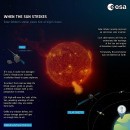It was September 1 when NASA warned the Parker Solar Probe could be heading into rough solar weather as it approaches the Sun for its 13th perihelion approach. Three days later, on September 4, the European Space Agency’s (ESA) Solar Orbiter got hit by “an enormous coronal mass ejection” (CME).
The Solar Orbiter was getting ready to perform its third flyby of Venus, coming as close as 6,000 km (3,728 miles) from the planet’s surface in a bid to get a better and closer trajectory around the Sun - after all, studying the star is the thing’s main mission.
As it did that, both the planet and the spacecraft got hit by the CME the Sun had spat out on August 30. Although it may all sound as horrifying, ESA says the Orbiter was designed to withstand such violent occurrences, so no harm came to the ship.
In fact, the Orbiter used the instruments it still had active during the Venus approach (most of them were switched off to protect them) to record data, and the info is just starting to be received by scientists here on Earth – we’ll probably learn more about what the data reveals in the near future.
Planet Venus, on the other hand, is severely affected each time the Sun is in a bad mood. As CMEs pass by the planet, they strip off the gasses in its atmosphere, making it less and less Earth’s sister.
“Gathering data on events like this is crucial to understanding how they arise, improving our space weather models, forecasts and early-warning systems,” said in a statement Alexi Glover, ESA Space Weather Service Coordinator.
“Solar Orbiter is providing us with an excellent opportunity to compare our forecasts with real observations and test how well our models and tools perform for these regions.”
The Solar Orbiter was launched in 2020 and is expected to stay up there, circling the Sun and spying on it, until the end of this decade.
As it did that, both the planet and the spacecraft got hit by the CME the Sun had spat out on August 30. Although it may all sound as horrifying, ESA says the Orbiter was designed to withstand such violent occurrences, so no harm came to the ship.
In fact, the Orbiter used the instruments it still had active during the Venus approach (most of them were switched off to protect them) to record data, and the info is just starting to be received by scientists here on Earth – we’ll probably learn more about what the data reveals in the near future.
Planet Venus, on the other hand, is severely affected each time the Sun is in a bad mood. As CMEs pass by the planet, they strip off the gasses in its atmosphere, making it less and less Earth’s sister.
“Gathering data on events like this is crucial to understanding how they arise, improving our space weather models, forecasts and early-warning systems,” said in a statement Alexi Glover, ESA Space Weather Service Coordinator.
“Solar Orbiter is providing us with an excellent opportunity to compare our forecasts with real observations and test how well our models and tools perform for these regions.”
The Solar Orbiter was launched in 2020 and is expected to stay up there, circling the Sun and spying on it, until the end of this decade.









